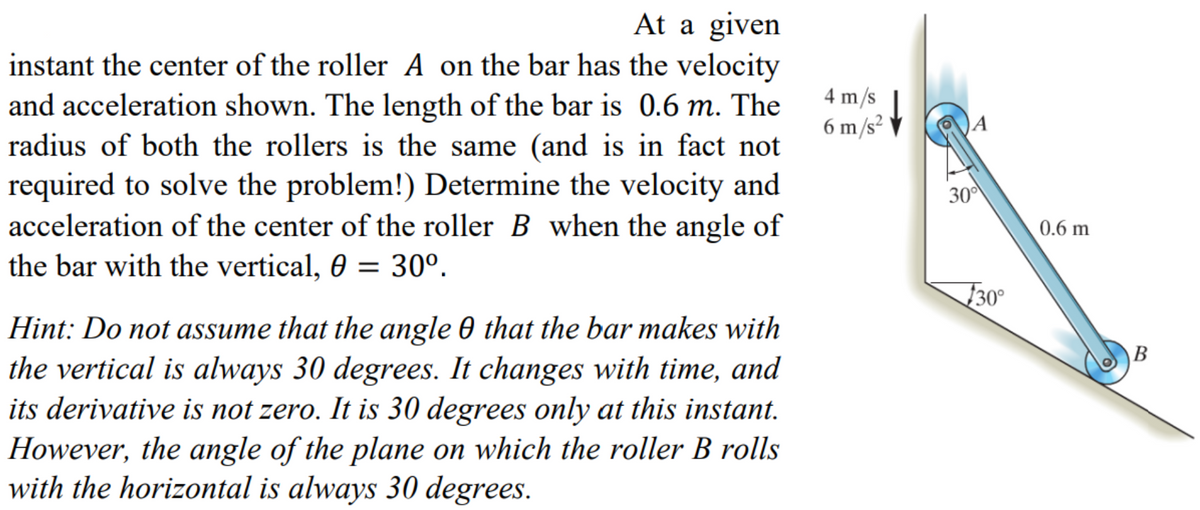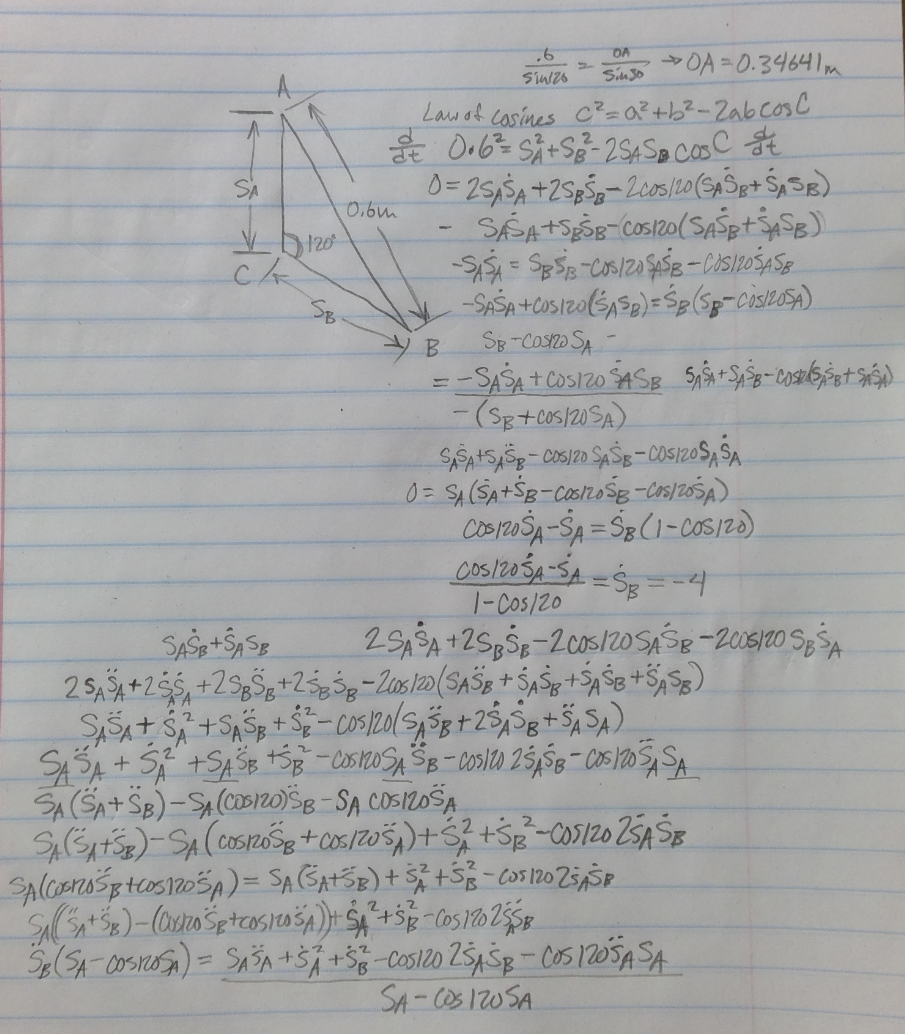At a given instant the center of the roller A on the bar has the velocity and acceleration shown. The length of the bar is 0.6 m. The radius of both the rollers is the same (and is in fact not required to solve the problem!) Determine the velocity and acceleration of the center of the roller B when the angle of the bar with the vertical, = 30⁰. Hint: Do not assume that the angle 0 that the bar makes with the vertical is always 30 degrees. It changes with time, and its derivative is not zero. It is 30 degrees only at this instant. However, the angle of the plane on which the roller B rolls with the horizontal is always 30 degrees. 4 m/s 6 m/s² A 30° 30° 0.6 m B
At a given instant the center of the roller A on the bar has the velocity and acceleration shown. The length of the bar is 0.6 m. The radius of both the rollers is the same (and is in fact not required to solve the problem!) Determine the velocity and acceleration of the center of the roller B when the angle of the bar with the vertical, = 30⁰. Hint: Do not assume that the angle 0 that the bar makes with the vertical is always 30 degrees. It changes with time, and its derivative is not zero. It is 30 degrees only at this instant. However, the angle of the plane on which the roller B rolls with the horizontal is always 30 degrees. 4 m/s 6 m/s² A 30° 30° 0.6 m B
Elements Of Electromagnetics
7th Edition
ISBN:9780190698614
Author:Sadiku, Matthew N. O.
Publisher:Sadiku, Matthew N. O.
ChapterMA: Math Assessment
Section: Chapter Questions
Problem 1.1MA
Related questions
Question
Please help I am having the hardest time trying to single out and remove S_a from the 2nd derivitive equation for acceleration so I can solve for S_b double dot. And at the instant S_a=S_b

Transcribed Image Text:At a given
instant the center of the roller A on the bar has the velocity
and acceleration shown. The length of the bar is 0.6 m. The
radius of both the rollers is the same (and is in fact not
required to solve the problem!) Determine the velocity and
acceleration of the center of the roller B when the angle of
the bar with the vertical, 0 = 30º.
Hint: Do not assume that the angle 0 that the bar makes with
the vertical is always 30 degrees. It changes with time, and
its derivative is not zero. It is 30 degrees only at this instant.
However, the angle of the plane on which the roller B rolls
with the horizontal is always 30 degrees.
4 m/s
6 m/s²
30⁰
30°
0.6 m
B

Transcribed Image Text:SA
CA
120°
SB
0.6m
→OA=0.34641m
Law of cosines C²=a²+b²-2abcos C
0.6²=SA+SB²-2SAS COSC t
6
DA
Sin/20 Sin 30
-
0=2SASA +255-2cos/20 (SASB+ SASR)
SASA+SESB-COS120(SASB+ SASB))
-S$1 = $8518-C05/20 $45B-CASTROSA SE
SAŠA + COSIZO (SA5₂) = S(Sp-CisSA)
B
Z
SB-COSIZO SA
=-SASA + COS120 SASB SASA+SA³B-COS (SA³B+ SASA)
-(SB+Cos/20SA)
SA+S-Csiz SS-COSI20 SASA
0= SA (SA+SB-Cos/20SB-C05/205A)
Cos/20SA-SA=S8 (1-COS/20)
Cos/20SA-SAS-4
1-Cos/20
2SASA +25BS-2Cos/20SASB-2005/20 SBSA
SASB+SASB
2 SASA +255 +255 +255B - 2005/20 (SASB + SASB + SASB+SASB)
SASA+SA+SASB + S2-COS/20(SA58 +2SAS+SASA)
SASA + SA² +SASB +5B - COSMOSA SB-COSI20 25A5B - COS/205A SA
SA (SA+SB)-SA (COS120) SB-SA COSIZOSA
SA(SA+SB)-SA (COSIOSB + Cos/20SA) +5² +SB²-C05/20 ZSASB
SA(Cors+os1205A) = SA (SA+SB) +5² +53-C05 120 25/50
SA (SA+ SB)-(Custo Sp+cos/205A))+ $A²+ SB-CO5 120 255B
SB (SA-COSIOSA) = SASA +57 +58-Cos120 25A5B-Cos 1205A SA
SA-COS 120SA
Expert Solution
This question has been solved!
Explore an expertly crafted, step-by-step solution for a thorough understanding of key concepts.
This is a popular solution!
Trending now
This is a popular solution!
Step by step
Solved in 2 steps with 2 images

Knowledge Booster
Learn more about
Need a deep-dive on the concept behind this application? Look no further. Learn more about this topic, mechanical-engineering and related others by exploring similar questions and additional content below.Recommended textbooks for you

Elements Of Electromagnetics
Mechanical Engineering
ISBN:
9780190698614
Author:
Sadiku, Matthew N. O.
Publisher:
Oxford University Press

Mechanics of Materials (10th Edition)
Mechanical Engineering
ISBN:
9780134319650
Author:
Russell C. Hibbeler
Publisher:
PEARSON

Thermodynamics: An Engineering Approach
Mechanical Engineering
ISBN:
9781259822674
Author:
Yunus A. Cengel Dr., Michael A. Boles
Publisher:
McGraw-Hill Education

Elements Of Electromagnetics
Mechanical Engineering
ISBN:
9780190698614
Author:
Sadiku, Matthew N. O.
Publisher:
Oxford University Press

Mechanics of Materials (10th Edition)
Mechanical Engineering
ISBN:
9780134319650
Author:
Russell C. Hibbeler
Publisher:
PEARSON

Thermodynamics: An Engineering Approach
Mechanical Engineering
ISBN:
9781259822674
Author:
Yunus A. Cengel Dr., Michael A. Boles
Publisher:
McGraw-Hill Education

Control Systems Engineering
Mechanical Engineering
ISBN:
9781118170519
Author:
Norman S. Nise
Publisher:
WILEY

Mechanics of Materials (MindTap Course List)
Mechanical Engineering
ISBN:
9781337093347
Author:
Barry J. Goodno, James M. Gere
Publisher:
Cengage Learning

Engineering Mechanics: Statics
Mechanical Engineering
ISBN:
9781118807330
Author:
James L. Meriam, L. G. Kraige, J. N. Bolton
Publisher:
WILEY